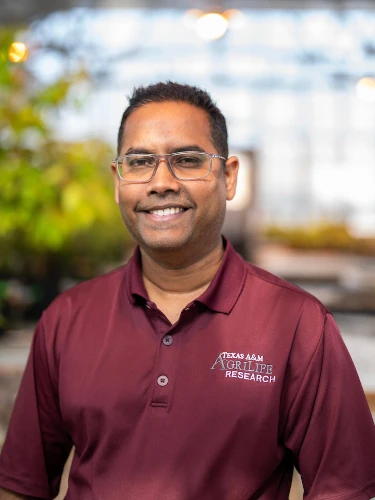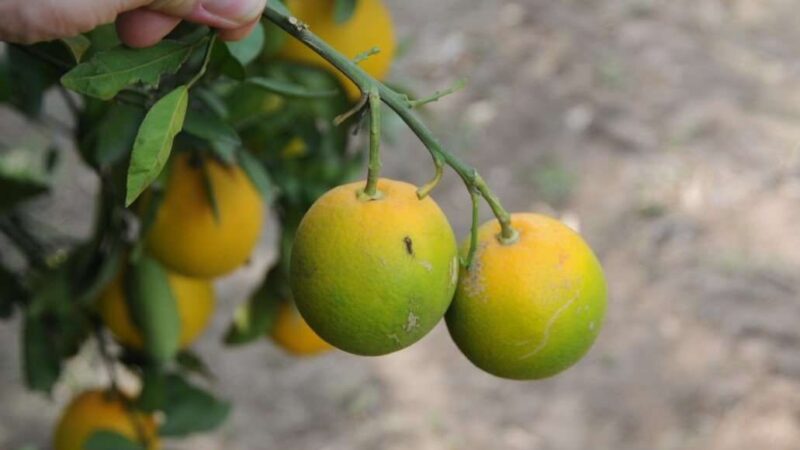Written by: Ashley Vargo, Communications Specialist, Texas A&M AgriLife
Multistate grant to investigate two innovative techniques for sustainable therapeutic delivery
Texas A&M AgriLife Research is launching a multi-institutional study to develop and evaluate systems that deliver treatments to trees affected by citrus greening disease, also known as Huanglongbing.
The project’s principal investigator is Kranthi Mandadi, Ph.D., AgriLife Research plant molecular biologist at the Texas A&M AgriLife Research and Extension Center at Weslaco and professor in the Texas A&M Department of Plant Pathology and Microbiology.
The three-year, $1.1 million project is supported by the Emergency Citrus Disease Research and Extension program, project award No. 2025-70029-44033, from the U.S. Department of Agriculture’s National Institute of Food and Agriculture.
The project builds on previous collaborative research that identified effective therapies and brings together researchers from Texas A&M AgriLife, the University of Florida and the University of California, Riverside, to improve the treatment’s delivery while minimizing damage to the trees.

Kranthi Mandadi, Ph.D., is leading a new collaborative effort exploring how to safely and effectively deliver therapies to trees affected by citrus greening. Crdit: Sam Craft, Texas A&M AgriLife
The challenge of treating citrus greening
Citrus greening is caused by the bacterium Candidatus Liberibacter asiaticus, which lives in the vasculature, or internal plumbing, of infected trees. The disease has devastated citrus groves across the U.S., particularly in Florida, Texas and California, the major citrus-producing states, leading to billions of dollars in lost revenue each year.
For applied therapies to work, they must reach the pathogen hidden away in the tree’s vasculature, where the pathogen resides. Application to the leaves or foliage by spraying does not allow adequate penetration of therapies due to the waxy and thick leaves of citrus.
Current treatments, such as antibiotic injections, have helped slow disease progression and improve yield in affected trees. However, applying them by trunk injections can cause structural damage, making the treatment method unsustainable for long-term orchard health.
“Traditional trunk injection methods could be effective in the short term to deliver therapies into tree trunks,” Mandadi said. “But with repeated use, they can weaken the structural integrity of a perennial tree.
“Citrus growers need alternative and practical vascular delivery approaches, regardless of which therapy is eventually used in the short or long term. Our goal in this project is to develop a more sustainable and scalable system for long-term therapeutic delivery for trees,” he said.
Two new delivery systems: aerial roots and lateral inarch grafts
To meet this need, the team plans to focus on two innovative systems that sidestep the need for trunk injections: aerial root systems and inarch graft injections. Both function as alternative entry points for delivering antibacterial compounds directly to where the citrus greening pathogen resides.
Once established, these systems could act as permanent or semi-permanent channels to enable repeated delivery of therapies without injuring the main tree trunk.
“These approaches offer multiple advantages,” said Sonia Irigoyen, Ph.D., co-principal investigator of the project and AgriLife Research senior research scientist at the Texas A&M AgriLife center at Weslaco. “They are less invasive, applicable to citrus trees of different ages and sizes, and they allow for repeatable treatments while minimizing application costs over time.”
David Laughlin, Ph.D., also an AgriLife Research senior research scientist at the center, said early findings suggest both aerial root uptake and inarch graft injections can be maintained over several seasons, as well as automated through centralized drip systems, suggesting the potential for large-scale implementation.
Collaboration across key citrus states
The research effort unites expertise from multiple institutions and growing regions. Other co-investigators include:
- Veronica Ancona, Ph.D., professor and plant pathologist at the Texas A&M University-Kingsville Citrus Center.
- Ute Albrecht, Ph.D., associate professor and extension specialist at the University of Florida Southwest Florida Research and Education Center.
- James Borneman, Ph.D., professor of plant pathology and microbiology at the University of California, Riverside.
“This is a true coast-to-coast collaboration,” said Amir Ibrahim, Ph.D., associate director and chief scientific officer of AgriLife Research. “We’re aligning the best expertise within Texas A&M AgriLife and our partner institutions to solve a key challenge that affects citrus growers in every major citrus-producing region.”
Long-term impact for the citrus industry
An extensive outreach component will ensure growers and citrus industry professionals benefit from the project’s findings through educational tools, field days and regional workshops across Texas, Florida and California.
Mandadi also believes the study’s findings could extend beyond improving the delivery and management of citrus greening therapies, possibly opening doors for precision nutrient delivery, growth and/or immune regulators, and technologies to boost citrus tree health and other tree crops beyond citrus.
“With continued efforts to improve the treatment of citrus greening, we hope to preserve orchard longevity and support the economic sustainability of the U.S. citrus industry for years to come,” he said.
The post AgriLife Research reimagines citrus greening treatment delivery originally appeared in Texas A&M AgriLife Today.



